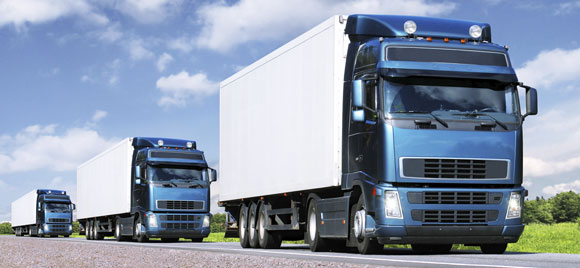Truck Platooning to become a reality
21/03/2016 00:00:00by Paul Fincham21/03/2016 00:00:00Truck Platooning to become a realityBluedrop Services

Next month will see six European truck manufacturers taking platoons of semi-automated trucks to Europe in a cross border challenge to raise awareness and accelerate the introduction of truck platoons.

What is truck platooning?
Truck platooning is when two or three trucks are linked in a convoy where those travelling closely behind react to the changes in movement of the leader. As they travel closely together and at a constant speed, due to connectivity technology and automated driving support systems, it results in reduced fuel consumption due to less braking and accelerating.
It is thought that truck platooning has the potential to reduce CO2 emissions by up to 10%. This form of connected driving will also help to improve safety with autonomous braking and can also optimise the delivery of goods and road utilisation and congestion.
This will be the worlds-first cross-border initiative which will see the trucks travel across a number of borders in a variety of European cities to reach their final destination at the Port of Rotterdam on April 6.
Why platooning?
Platooning means that trucks travel around 40 to 50 feet apart which sets up air flows that help to push both trucks forward. Drag accounts for up to 25% of a truck’s total fuel consumption, and the closer the trucks drive to each other the lower the drag and the greater the fuel-saving potential. Pelton Technology have run tests in conjunction with CR England to show that platooning has saved 7% of fuel at 65mph. 10% for the rear truck and 4.5% for the lead truck.
How does it work?
The wireless electronic communications system involved in platooning, which is connected to the internet, tells the second truck when the first one has applied brakes and it will therefore also brake instantaneously without any driver intervention. Due to the communications system the following trucks will know within ten milliseconds how fast the leader truck is travelling, how much engine torque is in place and the level of braking applied. This means that the reaction time for breaking is reduced to zero, which in turn improves safety and minimises the ‘accordion effect’ in connection with traffic congestion. The ‘following’ drivers taking part in a platoon will also have a video link provided by wireless communication to show the view of the road ahead of the leader driver, which can be used much like another mirror.
Platooning offers many benefits mainly to the customer, but also to society in the form of fuel savings, reduced emissions and enhanced transportation. To make truck platooning possible through the EU member states and private parties will need to come together with a view to crossing borders whilst also harmonising policies and technical issues.
With the reality of platooning coming closer to fruition, fleet insurance quotes will no doubt be affected and considerations within the insurance industry will need to be made upon risk and potential reduction in claims in terms of usage of such next generation vehicles. Watch this space.
Return to blog menuWant to find out more about Bluedrop's Fleet Insurance?
Call our friendly team now for the right insurance cover - at the best price
+441489780491
Calls recorded for training and quality.



 Privacy and Cookie Policy
Privacy and Cookie Policy